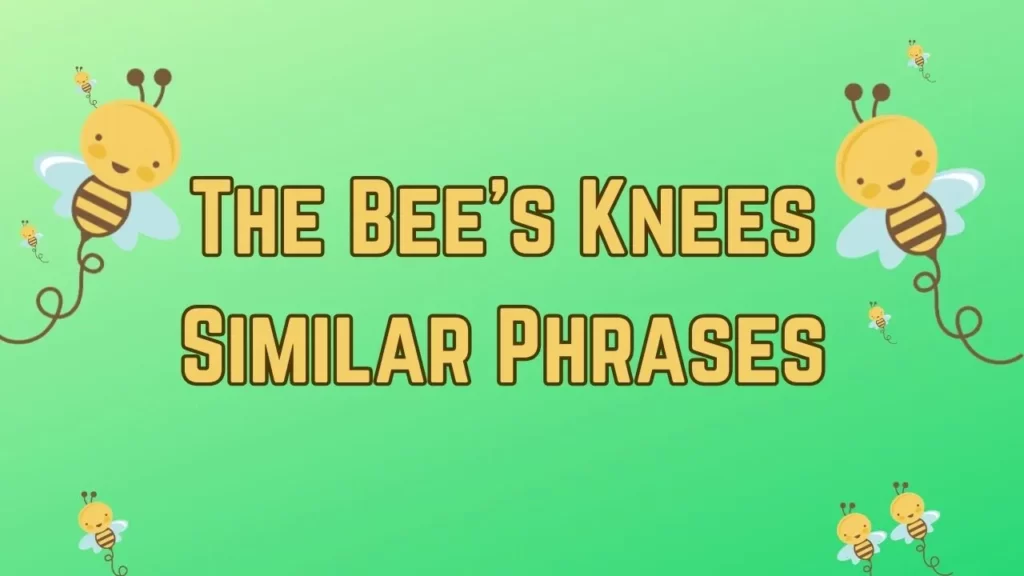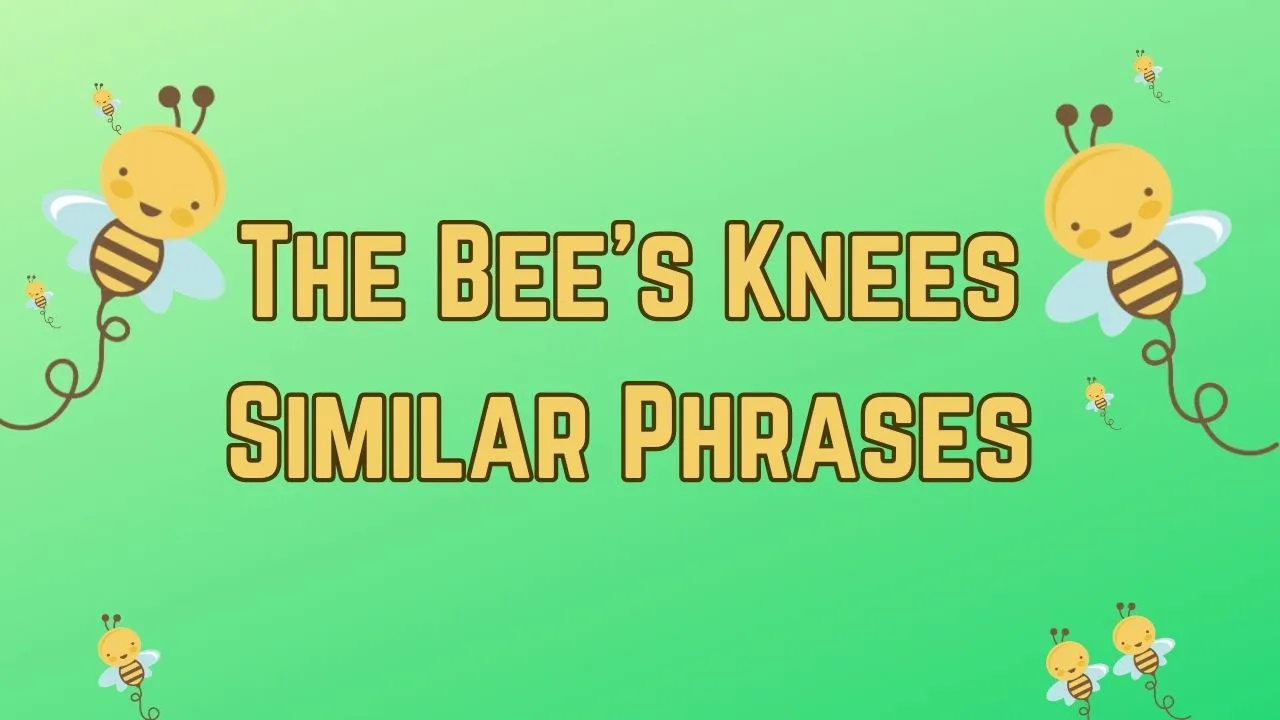Idioms and expressions enrich our conversations, providing depth and flair to our everyday communication. One such phrase that has stood the test of time is “the bee’s knees similar phrases.”

In this blog, we will delve into the origins, meaning, and variations of this fascinating idiom, along with other similar phrases that bring color to our language.
- The Cat’s Pajamas: This phrase is often used to describe something or someone that is exceptionally cool or impressive.
- The Dog’s Bollocks: This British slang term means something that is outstanding or excellent.
- The Ant’s Pants: Similar to “the bee’s knees,” this phrase is used to describe something that is outstanding or top-notch.
- The Duck’s Quack: This is a playful way to say that something is really great or impressive.
- The Tiger’s Roar: A phrase indicating that something is powerful, impressive, or remarkable.
- The Elephant’s Ears: Used to describe something that is particularly good or noteworthy.
- The Snake’s Hips: This phrase suggests something is stylish, trendy, or fashionable.
- The Owl’s Hoot: Used to convey that something is exceptional, often with a touch of whimsy.
- The Horse’s Mane: Similar to “the bee’s knees,” this phrase highlights something as extraordinary or exceptional.
- The Fox’s Socks: A playful way to express that something is really wonderful or impressive.
- The Penguin’s Waddle: Used to describe something that is charming, delightful, or endearing.
- The Lobster’s Claw: Indicates that something is excellent, exceptional, or of high quality.
- The Falcon’s Dive: This phrase suggests something is remarkable, perhaps with a sense of speed and precision.
- The Dolphin’s Leap: Used to convey the idea that something is impressive, dynamic, or full of energy.
- The Cheetah’s Sprint: Indicates that something is done with great speed, vigor, or excellence.
- The Giraffe’s Stretch: Used to describe something that is remarkable, reaching new heights, or achieving great success.
- The Kangaroo’s Jump: Suggests that something is extraordinary, perhaps with a sense of enthusiasm and vitality.
- The Eagle’s Gaze: This phrase implies that something is highly observant, discerning, or perceptive.
- The Squirrel’s Stash: Used to describe something that is cleverly arranged, well-organized, or resourceful.
- The Lion’s Roar: Indicates that something is impressive, bold, or powerful in its imp.
Alternatives of The Bee’s Knees Similar Phrases
Certainly, here are 10 alternatives to “the bee’s knees.”
- The Cream of the Crop: Referring to something or someone that is of the highest quality or excellence.
- The Top of the Heap: Suggesting that something is at the very best or highest level.
- The Pick of the Bunch: Used to describe the finest or most outstanding among a group.
- The Jewel in the Crown: Indicating something that is the most valuable or prized part of a collection.
- The Crème de la Crème: A French phrase that translates to “the cream of the cream,” used to describe the best of the best.
- The Prime Cut: This phrase often refers to something of the highest quality or the best choice.
- The A-List: Similar to “the bee’s knees,” this phrase describes the most esteemed or high-status group.
- The Star of the Show: Referring to something or someone that is the main attraction or the standout feature.
- The Masterpiece: Used to describe something that is a work of exceptional skill, artistry, or brilliance.
- The Hallmark of Excellence: Indicating a distinguishing mark of high quality or superior standards.
- The Gold Standard: Referring to something that sets the highest benchmark or example of excellence.
- The Pearl of Wisdom: Indicating a valuable piece of advice or insight that stands out.
- The Magic Touch: Suggesting that something or someone possesses a special quality that makes them exceptional.
- The Finest Hour: Used to describe a moment of greatness or achievement that stands above the rest.
- The Epitome of Perfection: Indicating that something represents the absolute pinnacle of perfection and excellence.
Unraveling the Bee’s Knees
When someone says, “It’s the bee’s knees,” they’re expressing high praise for something exceptional or outstanding. But have you ever wondered where this quirky phrase originated? The exact origin remains a subject of debate, but one theory suggests that it emerged in the 1920s during the jazz age in the United States. At that time, “bee’s knees” was part of a series of similar phrases like “cat’s whiskers” and “canary’s tusks,” all essentially denoting the same thing – excellence.
Buzzing through Similar Phrases
Just like the bee’s knees, there are several other idiomatic expressions that convey a similar sense of greatness. Let’s explore a few of them:
1. Cat’s Pajamas
Similar to the bee’s knees, the phrase “cat’s pajamas” also emerged during the 1920s. It reflects the same sentiment of something being extraordinary. Much like felines themselves, this expression exudes an air of sophistication and uniqueness.
2. Dog’s Bollocks
Originating from British slang, “dog’s bollocks” might sound a bit peculiar, but it’s used to describe something that’s considered the best. This phrase might not be suitable for all contexts due to its explicit nature, but it’s a prime example of language’s ability to evolve and adapt.
3. Elephant’s Eyelashes
While not as commonly used as the others, “elephant’s eyelashes” is another quirky phrase used to describe excellence. This whimsical expression reminds us of the imaginative ways language can capture the essence of greatness.
The Evolution of Language and Idioms
Idioms like the ones mentioned above remind us that language is a living entity that evolves with time. These phrases often find their roots in cultural contexts and societal changes, shaping and being shaped by the world around them. While their origins might be mysterious, their impact on language is undeniable.
Why Do We Use Such Expressions?
Using idioms like “the bee’s knees” and its variations serves a purpose beyond mere communication. They add a layer of creativity and playfulness to our conversations, allowing us to convey complex emotions and ideas in a concise and relatable manner. These expressions are like linguistic shortcuts, enabling us to capture a sentiment with just a few words.
FAQs
What can I say instead of the bees knees?
- The cat’s pajamas
- The tops
- The cream of the crop
- The height of fashion
- The ultimate
- The best thing since sliced bread
- The crème de la crème
- The pick of the bunch
- The shining star
- The prime example
Why do people say you’re the bee’s knees?
People use the phrase “you’re the bee’s knees” to express high praise and admiration for someone. The phrase is often used to convey that the person is exceptional, outstanding, or impressive in some way. It’s a playful and informal way of showing appreciation for someone’s qualities or actions.
How rare is the bees knees?
The phrase “the bee’s knees” is considered a somewhat rare idiom in modern English. While it was more popular in the 1920s and 1930s, it’s not as commonly used in everyday language today. However, it can still be found in certain contexts, especially when someone wants to add a touch of vintage charm or whimsy to their speech.
Final Thoughts
In the colorful tapestry of the English language, idioms like “the bee’s knees” and its kindred expressions play a vital role. They reflect our history, our culture, and our ever-evolving means of communication.
So, the next time you want to shower praise on something exceptional, feel free to use one of these whimsical phrases, knowing that you’re participating in a linguistic tradition that spans generations.
As language continues to grow and transform, let’s appreciate the richness it offers, one idiom at a time. Whether it’s the bee’s knees, the cat’s pajamas, or the elephant’s eyelashes, these expressions remind us that language is both an art and a reflection of human creativity.
Do have a similar expression in your language or do you know of any expressions like these in other languages?
Let us know in the comments section below 🙂
